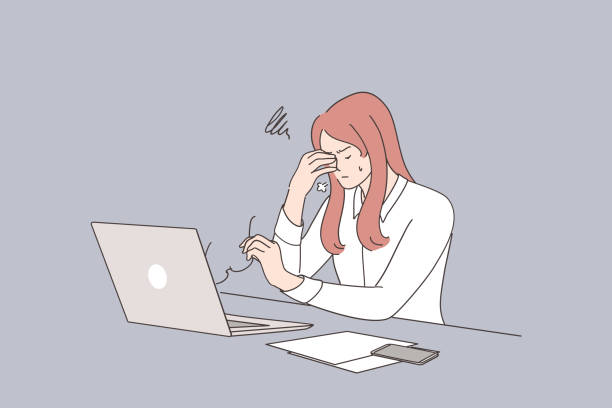In today’s digital world, many of us spend hours each day staring at screens. Whether it’s for work, school, or leisure, the constant use of smartphones, computers, and tablets can lead to a common issue known as digital eye strain. In this blog post, we’ll dive into what digital eye strain is, its causes, symptoms, and most importantly, how to prevent it.
Digital eye strain, also known as computer vision syndrome (CVS), refers to the discomfort that people experience after prolonged exposure to digital screens. The issue arises because our eyes are not naturally designed to focus on screens for long periods. This causes strain on the eye muscles, leading to various symptoms. Digital eye strain is becoming more common as technology plays a larger role in daily life.
Causes of Digital Eye Strain
1. Prolonged Screen Time

The most common cause of digital eye strain is spending long hours looking at screens. Whether it’s for work, gaming, or social media, the strain on your eyes increases when you’re constantly staring at a screen.
2. Improper Lighting
Poor lighting conditions can make it harder for your eyes to focus on a screen. Bright overhead lights, glare from windows, or dim lighting can contribute to digital eye strain. Your eyes have to work harder to adjust to the contrast, leading to fatigue.
3. Close Viewing Distance
Holding your device too close to your face can cause strain. When you hold your phone or tablet too near, your eyes must adjust constantly to focus on the screen. This can lead to eye discomfort and headaches.
4. Blinking Less
When staring at a screen, many people tend to blink less often. Blinking helps keep your eyes moist by spreading tears across the surface. Reduced blinking while using digital devices can lead to dry eyes, which increases discomfort.
5. Uncorrected Vision Problems
If you have an underlying vision problem like nearsightedness, farsightedness, or astigmatism, staring at a screen for long periods can worsen the symptoms. If your glasses or contact lenses prescription isn’t up to date, your eyes may experience additional strain.
Symptoms of Digital Eye Strain

1. Eye Fatigue
One of the most common symptoms of digital eye strain is tired, heavy eyes. After long hours of screen time, your eyes may feel exhausted, and you might even find it hard to focus on the screen.
2. Headaches
Many people experience headaches after using screens for long periods. These headaches are often caused by the strain on the eye muscles as they work to focus on the screen. The pain can range from mild to severe and is often accompanied by other symptoms of eye strain.
3. Dry Eyes
When staring at a screen, we tend to blink less frequently. This reduces the lubrication of the eyes, leading to dryness. Dry eyes can feel uncomfortable and may cause irritation, redness, or a gritty sensation.
4. Blurred Vision
Prolonged screen use can lead to blurred vision, especially when you shift your gaze from the screen to something else. The eyes have difficulty refocusing, causing blurry vision and discomfort.
5. Neck and Shoulder Pain
Sitting in one position for long periods while using a screen can lead to tension in your neck and shoulders. The strain on your muscles may cause stiffness or discomfort in these areas.
Prevention Tips for Digital Eye Strain

1. Follow the 20-20-20 Rule
A simple and effective way to reduce eye strain is by following the 20-20-20 rule. Every 20 minutes, look at something 20 feet away for at least 20 seconds. This gives your eyes a break and helps them relax after focusing on a screen.
2. Adjust Screen Settings
Make sure your screen brightness is comfortable. It should be roughly the same brightness as the surrounding environment. Additionally, adjust the text size on your screen to reduce the effort your eyes need to focus. Many devices also have “night mode” settings to reduce blue light, which can help reduce strain on your eyes.
3. Position Your Screen Properly
The position of your screen plays a significant role in reducing eye strain. Keep the top of the screen at or just below eye level and about 20-30 inches away from your eyes. Avoid sitting too close to the screen, and try to maintain a comfortable, upright posture.
4. Use Artificial Tears
If your eyes tend to get dry while using digital devices, consider using lubricating eye drops or artificial tears. These can help keep your eyes moist and prevent irritation. Make sure to choose preservative-free drops for daily use.
5. Take Regular Breaks
Frequent breaks are essential when using screens for long periods. Stand up, stretch, and move around every 30 minutes. This not only helps with eye strain but also reduces tension in your neck and shoulders.
6. Adjust Lighting in Your Environment
Ensure that the lighting in your room is appropriate. Avoid glare on your screen by positioning it away from windows or bright light sources. Use desk lamps with adjustable brightness to help reduce strain.
7. Consider Computer Glasses
If you wear glasses, you might want to try special computer glasses that are designed to reduce digital eye strain. These glasses have lenses that filter out blue light and reduce glare, helping to protect your eyes during prolonged screen use.
8. Regular Eye Exams
It’s essential to have regular eye exams to ensure that your vision is optimal. An eye care professional can detect any underlying vision problems that might contribute to digital eye strain. If you wear glasses or contacts, make sure your prescription is up to date.
Conclusion
Digital eye strain is a common issue, especially in today’s screen-dominated world. However, with a few simple changes, you can significantly reduce the discomfort associated with long hours of screen time. By following the 20-20-20 rule, adjusting your screen settings, improving your posture, and using eye drops, you can protect your eyes and feel better. If symptoms persist, it’s always a good idea to consult an eye care professional to ensure your eyes are healthy and your vision is correct.
Remember, taking care of your eyes today can help prevent more serious issues in the future. Stay mindful of your screen time, take breaks, and keep your eyes comfortable!

